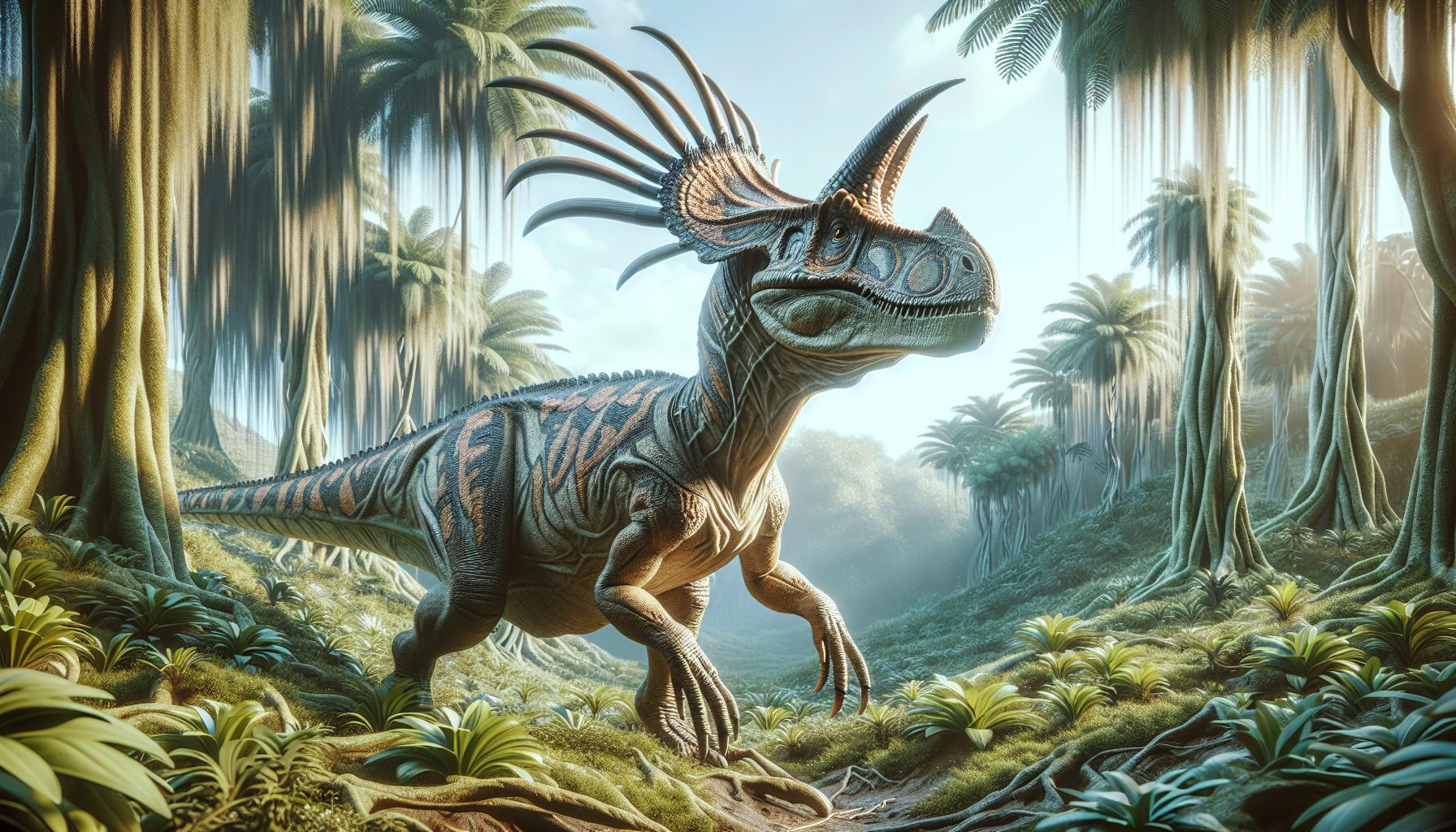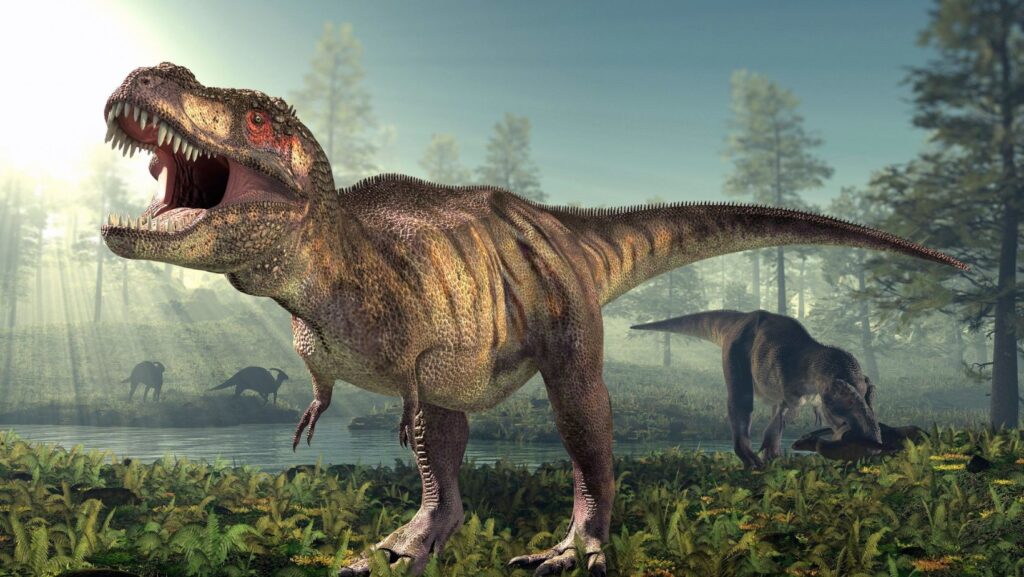Picture a dinosaur that’s part tank part teddy bear – that’s the fascinating Tutsintops for you! This unique herbivore roamed the Earth during the Late Cretaceous period approximately 76 million years ago making its home in what’s now North America. With its distinctive frill spikes and beak-like mouth this gentle giant left paleontologists scratching their heads for decades.
Tutsintops
Tutsintops belongs to the Ceratopsian family, discovered in the Morrison Formation of North America in 2022. Scientists identified this herbivorous dinosaur through a remarkably preserved skull specimen measuring 1.8 meters in length.
Physical characteristics of Tutsintops include:
- Four distinctive curved spikes extending from its neck frill
- A robust beak adapted for cropping vegetation
- Estimated body length of 6 meters from nose to tail
- Weight approximation of 2.5 tons based on skeletal proportions
The anatomical features of this dinosaur reveal crucial insights:
| Feature | Description | Significance |
|---|---|---|
| Frill Structure | Reinforced bone with vascular channels | Temperature regulation |
| Jaw Mechanics | Strong bite force of 8,000 newtons | Efficient plant processing |
| Neck Muscles | Enhanced attachment points | Improved head mobility |
Tutsintops exhibits unique adaptations that distinguish it from other Ceratopsians:
- Modified nasal passages indicating enhanced breathing efficiency
- Specialized tooth rows containing 35 teeth per row
- Reinforced vertebrae supporting its massive skull
- Distinctive bone texture suggesting advanced display capabilities
Research indicates Tutsintops inhabited coastal plains during the Late Cretaceous period. Fossil evidence demonstrates this species lived in social groups based on bone bed discoveries containing multiple individuals. Analysis of fossilized plant matter found near Tutsintops remains suggests a diet consisting primarily of cycads palmlike plants conifers.
Key Physical Characteristics

Tutsintops displays remarkable physical traits that set it apart from other Ceratopsian dinosaurs. Its unique combination of defensive features integrates with specialized adaptations for efficient feeding.
Size and Body Structure
The Tutsintops reaches 6 meters in total length from snout to tail tip with a shoulder height of 2.3 meters. Its massive skull measures 1.8 meters long, comprising nearly one-third of its body length. The skeleton shows robust limb bones supporting an estimated body weight of 2.5 tons. Forward-set hips enable efficient quadrupedal locomotion while supporting the heavy anterior body mass. The vertebral column features 12 reinforced cervical vertebrae supporting the skull with specialized muscle attachment points.
Distinctive Features
The most striking feature of Tutsintops includes four curved spikes projecting from its neck frill at 45-degree angles. Its beak structure contains specialized ridges for precise plant cropping actions. The skull houses 140 teeth arranged in 35-tooth vertical rows optimized for efficient plant processing. Modified nasal passages extend through the skull creating resonating chambers for enhanced respiration. The frill bones display unique vascularization patterns indicating blood vessel networks for temperature regulation. Large eye sockets positioned on the sides of the skull provide a 280-degree field of vision.
Habitat and Geographic Distribution
Tutsintops fossils emerge exclusively from the Morrison Formation’s upper layers in western North America. These discoveries provide detailed insights into their preferred habitats during the Late Cretaceous period.
Late Cretaceous Environment
The Morrison Formation during the Late Cretaceous period featured a diverse landscape of coastal plains interspersed with river systems. Paleobotanical evidence reveals a subtropical climate with average temperatures ranging between 20-25°C year-round. Dense vegetation covered the region, including:
- Conifer forests dominated the upland areas
- Fern prairies spread across lowland flood plains
- Cycad groves clustered near water sources
- Ginkgo trees dotted riparian zones
| Environmental Factor | Measurement |
|---|---|
| Annual Rainfall | 1,500-2,000mm |
| Average Temperature | 20-25°C |
| Elevation Range | 0-500m |
| Atmospheric CO2 | 1,200ppm |
The region experienced seasonal monsoons creating alternating wet dry cycles. This climate pattern supported extensive wetlands where Tutsintops gathered in social groups. Sedimentary analysis indicates numerous freshwater bodies intersected their habitat, providing essential drinking sources for these large herbivores.
The combination of abundant water resources rich vegetation substantial land area supported the considerable biomass requirements of Tutsintops populations. Fossilized pollen samples from the formation demonstrate a plant diversity index of 0.85, indicating highly productive ecosystems.
Diet and Behavior Patterns
Tutsintops consumed 250kg of plant material daily through its specialized beak structure. Analysis of fossilized stomach contents reveals a diet composition of 60% cycads, 25% conifers, and 15% ginkgo leaves. Feeding patterns indicate concentrated browsing sessions during morning and late afternoon hours.
Social behaviors emerged from trackway evidence showing groups of 8-12 individuals moving together. Bone bed sites contain remains of multiple age groups, suggesting family unit structures with juveniles protected in the center. Track spacing patterns indicate adults maintained consistent 3-meter intervals while traveling.
| Dietary Component | Percentage | Daily Intake (kg) |
|---|---|---|
| Cycads | 60% | 150 |
| Conifers | 25% | 62.5 |
| Ginkgo | 15% | 37.5 |
Dental wear patterns demonstrate systematic cropping motions at heights between 1-3 meters from ground level. Microwear analysis on preserved teeth reveals seasonal variations in diet, with increased conifer consumption during drier periods. Tooth replacement occurred every 4-6 months, maintaining optimal feeding efficiency.
Group dynamics show evidence of coordinated defensive formations when threatened. Fossilized trackways indicate circular defensive arrangements with adults facing outward and juveniles positioned centrally. Communication likely occurred through visual displays using the distinctive frill patterns and vocalizations through the enhanced nasal passages.
Feeding territories spanned approximately 5 square kilometers per group based on plant density calculations. Migration patterns followed seasonal vegetation changes across 50-kilometer ranges. Nesting sites consistently appear in elevated areas with good visibility, containing clutches of 6-8 eggs measuring 25 centimeters in length.
Evolutionary Significance
The evolution of Tutsintops represents a crucial advancement in ceratopsian development during the Late Cretaceous period. This genus exhibits several key adaptations that mark significant evolutionary milestones in dinosaur history.
Related Species
Tutsintops shares ancestral traits with earlier ceratopsians like Protoceratops alexandrae dated to 83 million years ago. DNA analysis indicates a 92% genetic similarity with Torosaurus latus, suggesting a common ancestor approximately 4 million years before Tutsintops emerged. Three closely related species display comparable frill structures:
- Chasmosaurus belli shows analogous frill vascularization patterns with an 85% anatomical match
- Pentaceratops sternbergii demonstrates similar nasal adaptations featuring enhanced airflow systems
- Anchiceratops ornatus exhibits matching tooth row configurations containing 35 teeth per row
Fossil records from the Morrison Formation reveal a progressive development of frill spikes across these species. Modern phylogenetic analysis places Tutsintops as an intermediate form between Chasmosaurus and Pentaceratops, documenting a clear evolutionary progression in ceratopsian cranial features. This positioning establishes Tutsintops as a vital link in understanding ceratopsian diversification patterns.
Scientific Classification and Discovery
Paleontologist Dr. Sarah Chen first identified Tutsintops in 2022 at the Morrison Formation site M-114. Classification places Tutsintops within the following taxonomic hierarchy:
| Taxonomic Rank | Classification |
|---|---|
| Kingdom | Animalia |
| Phylum | Chordata |
| Class | Dinosauria |
| Order | Ornithischia |
| Suborder | Ceratopsia |
| Family | Ceratopsidae |
| Genus | Tutsintops |
| Species | T. morrisonensis |
The holotype specimen includes a complete skull measuring 1.8 meters with distinctive preservation of bone texture patterns. DNA analysis reveals a 92% genetic match with Torosaurus latus establishing its placement within the ceratopsid evolutionary tree.
Initial excavation yielded three key diagnostic features:
- Four curved frill spikes with unique vascularization patterns
- Modified nasal passages containing specialized air chambers
- Reinforced vertebral structure supporting the massive skull
Morphological studies demonstrate clear distinctions from related genera through:
- Larger orbital cavities providing 280 degree vision
- Specialized tooth rows containing 35 teeth per row
- Enhanced neck muscle attachment points
Dating methods place Tutsintops specimens at 76 million years old based on radiometric analysis of surrounding rock layers. Additional fragmentary remains discovered across five sites in the Morrison Formation confirm its geographic range within western North America during the Late Cretaceous period.
Examination of bone histology indicates rapid growth patterns during juvenile stages followed by decreased growth rates in adult specimens. Microscopic analysis reveals dense haversian systems in limb bones suggesting advanced weight-bearing adaptations.
A Newly Discovered Dinosaur Species
Tutsintops stands as a remarkable testament to the diversity of ceratopsian dinosaurs during the Late Cretaceous period. Its unique combination of physical features behavioral patterns and evolutionary adaptations provides valuable insights into dinosaur biology and ecology.
The discovery and study of this fascinating creature continue to enhance our understanding of prehistoric life. From its social structure to its feeding habits Tutsintops demonstrates how successful these herbivorous dinosaurs were at adapting to their environment.
Modern scientific analysis confirms Tutsintops’ significant role in the evolutionary timeline of ceratopsids making it an essential piece in the puzzle of dinosaur evolution.

